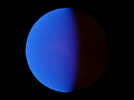For years, Blue Origin has been working on a vertical-launched rocket that could someday take passengers on an automated trip beyond 62 miles (100 kilometers) in altitude. That’s beyond the boundary of outer space – at a height where passengers could see the blue, curving Earth beneath the blackness of space, and experience a few minutes of weightlessness.
Today’s announcement is notable not just because it represents a rare update from Blue Origin, but also because it marks a step forward for suborbital science. “This is the first time that a next-gen suborbital company has selected payloads to fly in space,” Alan Stern, planetary scientist and former NASA science official told me.
The three experiments are:
* “Three-Dimensional Critical Wetting Experiment in Microgravity.” Principal investigator: Stephen Collicott of Purdue University. Collicott’s research focuses on how fluids behave in zero-gravity environments. Such studies are crucial for propulsion system design.
* “Microgravity Experiment on Dust Environments in Astrophysics” (MEDEA). Principal investigator: Joshua Colwell, of the University of Central Florida. Colwell’s experiment is aimed at shedding light on the process by which space dust builds up to form planets, or the rings around those planets.
* “Effective lnterfacial Tension lnduced Convection” (EITIC). Principal investigator: John Pojman, of Louisiana State University. Pojman concentrates on the interaction of fluids in zero-G.
Blue Origin has said that the first experiments could fly during New Shepard’s unmanned testing phase in 2011, and that experiments requiring human tending could be taken up starting in 2012. That schedule is still operative, but it’s too early to be more specific about the launch timing, Stern told me.
Posted: Monday, November 23, 2009 8:45 PM by Alan Boyle. To read the entire article titled, Suborbital Science Goes Public, visit the Web site.
